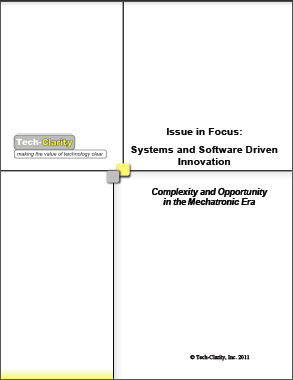 Issue in Focus: Systems and Software Driven Innovation – Complexity and Opportunity in the Mechatronic Era describes the fundamental shift to increased software and electronics in traditionally mechanical products, sometimes known as “mechatronics.” The report explains the need to manage the resulting design complexity and how to take advantage of the opportunities offered by systems and software based products.
Issue in Focus: Systems and Software Driven Innovation – Complexity and Opportunity in the Mechatronic Era describes the fundamental shift to increased software and electronics in traditionally mechanical products, sometimes known as “mechatronics.” The report explains the need to manage the resulting design complexity and how to take advantage of the opportunities offered by systems and software based products.
Please enjoy the summary below, or click the report or title to download a PDF overview of the report (free of charge, no registration required). Please visit the PTC website to download the full report (free of charge, no registration required).
Table of Contents
- Introducing the Issue
- The Mechatronics Imperative
- The Complexity of Mechatronic Products
- Managing Change in Mechatronic Products
- Working Together – The Systems View
- The Opportunity to Innovate with Systems and Software
- Competing through Software Driven Innovation
- Enabling Software Driven Innovation
- PLM and Software Driven Innovation
- The Current Reality of PLM for Systems
- Conclusion
- Recommendations
- About the Author
Introducing the Issue
Modern products increasingly incorporate a combination of mechanical, electrical, and software components that allow innovative designers to take advantage of sensors and logic to solve problems and provide capabilities in new ways. This impacts the way companies innovate. As manufacturers develop their next generation of products, they are more likely to turn to electronics and software to make a “smarter” mousetrap as opposed to innovating solely in their mechanical design.
Over the last decade, there has been a steady, fundamental shift towards increased software and electronics in traditionally mechanical products. Engineers have added more monitoring and more sophisticated controls, and have increased the amount of product functionality and value delivered through software as compared to mechanics. Examples of this shift range from automobiles, to mobile devices, to “simple” household appliances.
This changing paradigm requires multiple design disciplines to work together to develop a working system. Systems that rely more heavily on the combination of mechanics, electronics, and software demand more integrated engineering and validation processes. The shift has driven higher levels of product development and engineering complexity starting in the early requirements phase of a product, continuing through design, making a significant impact on product testing and validation, and continuing as a configuration management issue throughout the product lifecycle.
